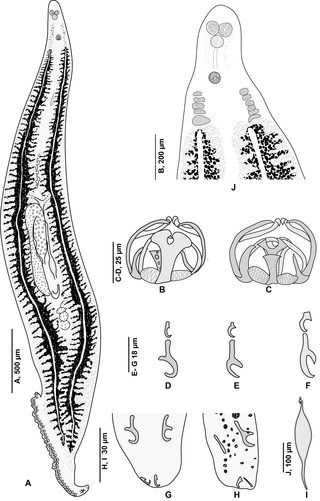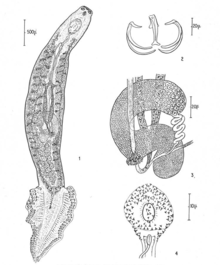
Microcotylidae is a family of polyopisthocotylean monogeneans. All the species in this family are parasitic on fish.

Microcotyle archosargi is a species of monogenean, parasitic on the gills of a marine fish. It belongs to the family Microcotylidae. It was first described by MacCallum in 1913 based on ten specimens. Hargis (1956) pointed out that the description and figures given by MacCallum were poor in details.

Microcotyle algeriensis is a species of monogenean, parasitic on the gills of a marine fish. It belongs to the family Microcotylidae.
Microcotyle bassensis is a species of monogenean, parasitic on the gills of a marine fish. It belongs to the family Microcotylidae.

Microcotyle centropristis is a species of monogenean, parasitic on the gills of a marine fish. It belongs to the family Microcotylidae.
Microcotyle poronoti is a species of monogenean, parasitic on the gills of a marine fish. It belongs to the family Microcotylidae.
Microcotyle cepolae is a species of monogenean, parasitic on the gills of a marine fish. It belongs to the family Microcotylidae.
Microcotyle sebastisci is a species of monogenean, parasitic on the gills of marine fish. It belongs to the family Microcotylidae.
Microcotyle victoriae is a species of monogenean, parasitic on the gills of a marine fish. It belongs to the family Microcotylidae.
Microcotyle toba is a species of monogenean, parasitic on the gills of a marine fish. It belongs to the family Microcotylidae.
Microcotyle tanago is a species of monogenean, parasitic on the gills of a marine fish. It belongs to the family Microcotylidae.

Microcotyle sebastis is a species of monogenean, parasitic on the gills of a marine fish. It belongs to the family Microcotylidae.
Microcotyle danielcarrioni is a species of monogenean, parasitic on the gills of a marine fish. It belongs to the family Microcotylidae.
Microcotyle moyanoi is a species of monogenean, parasitic on the gills of a marine fish. It belongs to the family Microcotylidae.

Pseudaxine is a genus which belongs to the phylum Platyhelminthes and class Monogenea; all its species are parasites of fish.
Cynoscionicola is a genus which belongs to the family Microcotylidae and class Monogenea. Species of Cynoscionicola are ectoparasites that affect their host by attaching themselves as larvae on the gills of the fish and grow into adult stage. This larval stage is called oncomiracidium, and is characterized as free swimming and ciliated. This genus was proposed by Price in 1962, to accommodate Cynoscionicola heteracantha and Cynoscionicola pseudoheteracantha . Members of Cynoscionicola are characterised by a genital atrium with two anterior muscular pockets armed with single row of hooked spines, and two posterior lateral muscular pouches armed with spines.
Metamicrocotyla is a genus which belongs to the family Microcotylidae and class Monogenea. It was created by Yamaguti in 1953 to include Metamicrocotyla bora and Metamicrocotyla filiformis from the gills off the flathead grey mullet Mugil cephalus (Mugilidae). As all Monogenea, species of Metamicrocotyla are ectoparasites that affect their host by attaching themselves as larvae on the gills of the fish and grow into adult stage. This larval stage is called oncomiracidium, and is characterized as free swimming and ciliated. Members of Metamicrocotyla are characterized by a symmetrical haptor, a variable number of postovarian testes and with no cirrus nor vagina. their genital atrium is provided with paired groups of spines or hooks.

Microcotylinae is a subfamily within family Microcotylidae and class Monogenea. This subfamily was created by Taschenberg in 1879.
Bivagina is a genus of monogeneans. As all Monogenea, species in the genus are ectoparasites that affect their host by attaching themselves as larvae on the gills of fish and grow into adult stage. This larval stage is called oncomiracidium, and is characterized as free swimming and ciliated.
Diplasiocotyle is a genus which belongs to the family Microcotylidae and class Monogenea. As all Monogenea, species of Microcotylidae are ectoparasites that affect their host by attaching themselves as larvae on the gills of the fish and grow into adult stage. This larval stage is called oncomiracidium, and is characterized as free swimming and ciliated.







